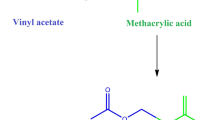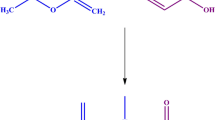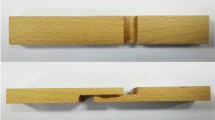Abstract
Commercially available polyvinyl alcohol (PVA) stabilized polyvinyl acetate (PVAc) emulsion adhesives produce affordable, colourless gluelines with an extremely durable connection to various types of wood. At room temperature, the adhesive solidifies as a result of water evaporation. Plasticizers are required for the PVAc emulsion; however, they have drawbacks that affect their mechanical and thermal properties. On the other hand, they demonstrate limited strength at high relative humidity and high temperatures and are neither heat- nor moisture-resistant. The goal of the present research is to develop a plasticizer-free glue by copolymerizing vinyl acetate (VAc), vinyl neodecanoate (VeoVa), and methyl methacrylate (MMA) with butyl acrylate (BA). The sample with BA is also put together with PVA solution, aluminium nitrate, and preservatives, and it is tested with the copolymer sample without BA. The viscosity, pH, water contact angle, scratch resistance of the films, and differential scanning calorimetry measurements were used to analyse the physical, thermal, and mechanical properties of adhesives containing BA. The shear strength of the samples on the wood specimen was evaluated in dry and wet conditions in accordance with EN 204-205. The viscosity of the adhesives increased as the BA concentration increased. The hardness of the adhesive films was adversely impacted by the addition of BA. The hydrophobic properties of the BA addition were confirmed through measurements of the water contact angle. The tensile shear strength value evaluated under dry conditions after 6 h of drying demonstrated a 9.5% increase on the 1 wt% BA sample in comparison to pristine glue. Analysis of performance in wet situations also showed that BA addition improved performance. By adjusting the amount of BA, a novel water-resistant crosslinked emulsion adhesive without any plasticizer can be developed with enhanced water resistance and performance. The technique used to increase the wood adhesive's resistance to moisture was affordable, plasticizer-free, and environmentally safe.









Similar content being viewed by others
References
Anderson NCLWRT One part woodworking adhesive composition, US6872278B2, 2022. https://patents.google.com/patent/US6872278B2/en
Chen L, Xiong Z, Xiong H, Wang Z, Din Z, Nawaz A, Wang P, Hu C (2018) Effects of nano-TiO2 on bonding performance, structure stability and film-forming properties of starch-g-VAc based wood adhesive. Carbohydr Polym 200:477–486. https://doi.org/10.1016/j.carbpol.2018.08.023
Choi Y-M, Lee B-H, Park J-W, Kim H-J, Eom YG, Jang S-W, Lee Y-K (2013) Adhesion properties of eco-friendly PVAc emulsion adhesive using nonphthalate plasticizer. J Adhes Sci Technol 27:536–550. https://doi.org/10.1080/01694243.2012.705481
Desmet GB, Marien YW, Van Steenberge PHM, D.R. D’hooge, M.-F. Reyniers, G.B. Marin, (2017) Ab initio based kinetic Monte Carlo analysis to unravel the propagation kinetics in vinyl acetate pulsed laser polymerization. Polym Chem 8:7143–7150. https://doi.org/10.1039/C7PY01008G
Dossi M, Liang K, Hutchinson RA, Moscatelli D (2010) Investigation of free-radical copolymerization propagation kinetics of vinyl acetate and methyl methacrylate. J Phys Chem B 114:4213–4222. https://doi.org/10.1021/jp1007686
Duquesne S, Lefebvre J, Delobel R, Camino G, LeBras M, Seeley G (2004) Vinyl acetate/butyl acrylate copolymers—part 1: mechanism of degradation. Polym Degrad Stab 83:19–28. https://doi.org/10.1016/S0141-3910(03)00176-9
Ferrándiz-Gómez TD, Fernández-García JC, Orgilés-Barceló AC, Martín-Martínez JM (1996) Effects of hydrocarbon tackifiers on the adhesive properties of contact adhesives based on polychloroprene. I. Influence of the amount of hydrocarbon tackifier. J Adhes Sci Technol 10:833–845. https://doi.org/10.1163/156856196X00887
Gadhave RV, Vineeth SK (2022) Synthesis and characterization of starch stabilized polyvinyl acetate-acrylic acid copolymer-based wood adhesive. Polym Bull. https://doi.org/10.1007/s00289-022-04558-8
Gadhave RV, Mahanwar PA, Gadekar PT (2021) Effect of addition of boric acid on thermo-mechanical properties of microcrystalline cellulose/polyvinyl alcohol blend and applicability as wood adhesive. J Adhes Sci Technol 35:1072–1086. https://doi.org/10.1080/01694243.2020.1832775
Gong Y, Shao T, Wang X, Zhang X, Sun Z, Chen L (2019) Preparation and characterisation of modified VAc-VeoVa10 latex. Pigment Resin Technol 48:210–215. https://doi.org/10.1108/PRT-05-2018-0045
Haruo Okazaki TO, Aqueous vinyl acetate copolymer emulsion adhesives, GB2101141A, 1979. https://patents.google.com/patent/GB2101141A/en.
Jiang BQ, Hu SF, Zeng JN, Wang MW (2010) Copolymerization of organosilicone-Veova10-VAc emulsion modified with protective colloid of PAM-PEG. Adv Mater Res 168–170:2060–2064. https://doi.org/10.4028/www.scientific.net/AMR.168-170.2060
Kaboorani A, Riedl B, Blanchet P, Fellin M, Hosseinaei O, Wang S (2012) Nanocrystalline cellulose (NCC): a renewable nano-material for polyvinyl acetate (PVA) adhesive. Eur Polym J 48:1829–1837. https://doi.org/10.1016/j.eurpolymj.2012.08.008
Kalapathy U, Hettiarachchy NS, Myers D, Hanna MA (1995) Modification of soy proteins and their adhesive properties on woods. J Am Oil Chem Soc 72:507–510. https://doi.org/10.1007/BF02638849
Kong XZ, Pichot C, Guillot J (1987) Characterization of particle surface and morphology in vinyl acetate-butyl acrylate emulsion copolymers ? Influence of the copolymerization pathway. Colloid Polym Sci 265:791–802. https://doi.org/10.1007/BF01418455
Kong XZ, Pichot C, Guillot J (1988) Kinetics of emulsion copolymerization of vinyl acetate with butyl acrylate. Eur Polym J 24:485–492. https://doi.org/10.1016/0014-3057(88)90090-0
Lanthong P, Nuisin R, Kiatkamjornwong S (2006) Graft copolymerization, characterization, and degradation of cassava starch-g-acrylamide/itaconic acid superabsorbents. Carbohydr Polym 66:229–245. https://doi.org/10.1016/j.carbpol.2006.03.006
Luo JSZ, Liu P, Xu W, Fu J, Xu L Flame-retardant decorative veneer, CN101412230B, 2008. https://patents.google.com/patent/CN101412230B/en
Maciá-Agulló TG, Fernández-García JC, Pastor-sempere N, Orgilés-Barceló AC, Martín-Martínez JM (1992) Addition of Silica to Polyurethane Adhesives. J Adhes 38:31–53. https://doi.org/10.1080/00218469208031266
Marinich JA, Ferrero C, Jiménez-Castellanos MR (2012) Graft copolymers of ethyl methacrylate on waxy maize starch derivatives as novel excipients for matrix tablets: Drug release and fronts movement kinetics. Eur J Pharm Biopharm 80:674–681. https://doi.org/10.1016/j.ejpb.2011.12.005
Miyamoto Masahiro, Vinyl ester resin composition that contains polymer fine particles, process for production of same, and cured products of same, EP2441784B1, 2007. https://patents.google.com/patent/EP2441784B1/en
Matsumoto M, Hirata-Koizumi M, Ema M (2008) Potential adverse effects of phthalic acid esters on human health: a review of recent studies on reproduction. Regul Toxicol Pharmacol 50:37–49. https://doi.org/10.1016/j.yrtph.2007.09.004
Mingyue Z, Weihong Q, Hongzhu L, Yingli S (2008) Synthesis of a novel polymerizable surfactant and its application in the emulsion polymerization of vinyl acetate, butyl acrylate, Veova 10, and hexafluorobutyl methacrylate. J Appl Polym Sci 107:624–628. https://doi.org/10.1002/app.27123
O.P. Pamela Schrögel, Florian Bauers, Aqueous polymer dispersions for adhesives, DE102015200498A1, 2014. https://patents.google.com/patent/DE102015200498A1/en
Pastor-sempere N, Fernández-garcía JC, Orgilés-barceló AC, Torregrosa-maciá R, Martín-martínez JM (1995) Fumaric Acid as a Promoter of Adhesion in Vulcanized Synthetic Rubbers. J Adhes 50:25–42. https://doi.org/10.1080/00218469508027111
Poh BT, Firdaus SZ (2010) Effect of hybrid tackifiers on adhesion properties of epoxidized natural rubber-based pressure-sensitive adhesives. J Polym Environ 18:335–338. https://doi.org/10.1007/s10924-010-0197-9
Qiao Z, Gu J, Zuo Y, Tan H, Zhang Y (2014) The effect of carboxymethyl cellulose addition on the properties of starch-based wood adhesive. BioResources. https://doi.org/10.15376/biores.9.4.6117-6129
Rosdi MRH, Ariffin A (2016) Evaluation of flow ability response in EVA emulsion preparation with different vinyl acetate percentage by intrinsic viscosity measurement. Procedia Chem 19:455–461. https://doi.org/10.1016/j.proche.2016.03.038
Sarac A, Yildirim H (2006) Semi-continuous emulsion copolymerization of vinyl acetate and butyl acrylate using a new protective colloid Part 1 Effect of different emulsifiers. Polym Adv Technol 17:855–859. https://doi.org/10.1002/pat.834
Xiao X, Wang Y (2009) Emulsion copolymerization of fluorinated acrylate in the presence of a polymerizable emulsifier. Colloids Surfaces A Physicochem Eng Asp 348:151–156. https://doi.org/10.1016/j.colsurfa.2009.07.006
Zhang L, Yang J-H, Wang X-Y, He X, Zhao B, Tang Z-H, Yang G-Z, Qiu H-X (2011) Thermal properties of poly(vinyl chloride-co-vinyl acetate-co-2-hydroxypropyl acrylate) (PVVH) polymer and its application in ZnO Based nanogenerators. Chinese Phys Lett 28:016501. https://doi.org/10.1088/0256-307X/28/1/016501
Zhang Y, Pan S, Ai S, Liu H, Wang H, He P (2014) Semi-continuous emulsion copolymerization of vinyl acetate and butyl acrylate in presence of AMPS. Iran Polym J 23:103–109. https://doi.org/10.1007/s13726-013-0205-8
Zhang Y, Pang B, Yang S, Fang W, Yang S, Yuan T-Q, Sun R-C (2018) Improvement in wood bonding strength of poly (vinyl acetate-butyl acrylate) emulsion by controlling the amount of redox initiator. Materials (basel) 11:89. https://doi.org/10.3390/ma11010089
Zhang Y, Bei W, Qin Z (2020) Preparation and characterization of soap-free vinyl acetate/butyl acrylate copolymer latex. Materials (basel) 13:865. https://doi.org/10.3390/ma13040865
Zhao C, Peng G, Liu B, Jiang Z (2011) Synergistic effect of organically modified layered double hydroxide on thermal and flame-retardant properties of poly(butyl acrylate–vinyl acetate). J Polym Res 18:1971–1981. https://doi.org/10.1007/s10965-011-9604-8
Zia-ud-Din L, Chen I, Ullah PK, Wang AB, Javaid C, Hu M, Zhang I, Ahamd H, Xiong Z (2018) Synthesis and characterization of starch-g-poly(vinyl acetate-co-butyl acrylate) bio-based adhesive for wood application. Int J Biol Macromol 114:1186–1193. https://doi.org/10.1016/j.ijbiomac.2018.03.178
Acknowledgements
We would like to thank Institute of Chemical Technology, Mumbai, India, for the support throughout this work.
Funding
This research did not receive any specific grant from funding agencies in the public, commercial, or not-for-profit sectors.
Author information
Authors and Affiliations
Corresponding author
Ethics declarations
Conflict of interest
The authors declare no conflict of interest.
Additional information
Publisher's Note
Springer Nature remains neutral with regard to jurisdictional claims in published maps and institutional affiliations.
Rights and permissions
Springer Nature or its licensor (e.g. a society or other partner) holds exclusive rights to this article under a publishing agreement with the author(s) or other rightsholder(s); author self-archiving of the accepted manuscript version of this article is solely governed by the terms of such publishing agreement and applicable law.
About this article
Cite this article
Gadhave, R.V. Water-resistant wood adhesive without plasticizers: synthesis and characterization. J Indian Acad Wood Sci 21, 135–146 (2024). https://doi.org/10.1007/s13196-024-00332-7
Received:
Accepted:
Published:
Issue Date:
DOI: https://doi.org/10.1007/s13196-024-00332-7




